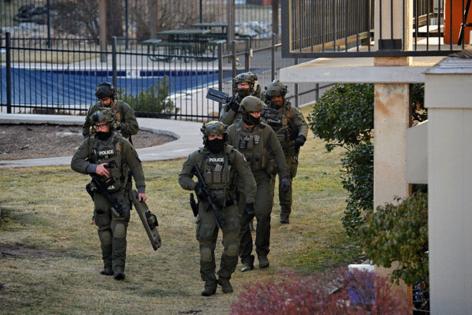Rifles, stun grenades, armored trucks in ICE raids spur tensions
Published in News & Features
The Trump administration is intensifying efforts to round up migrants. It’s also doing so with increasingly aggressive tactics.
In scenes from San Diego to Massachusetts, agents outfitted with bullet-resistant vests and often displaying military-style rifles are shown in social media videos and photos being escorted along city streets by armored vehicles. A clip from Rhode Island shows an agent standing in a truck’s open hatch, manning a rifle.
The operations led by Immigration and Customs Enforcement, often joined by local law enforcement, have coincided with a dramatic increase in arrests of people for running afoul of immigration laws — with ICE reporting more than 1,600 daily apprehensions. That’s more than double the 630 average of recent weeks and a roughly 450% increase over typical numbers during former President Joe Biden’s last year in office.
The latest figures are still barely half of the administration’s goal, but the White House is rapidly moving forward with efforts to remove legal obstacles to deportations while ramping up prison capacity and enforcement capability. In the meantime, it’s deploying social-media videos with quick edits and throbbing techno beats, made-for-TV moments to get attention.
“This is not normal,” said David Shirk, a political science professor and expert on U.S.-Mexico border issues at the University of San Diego. “It is a response to what has been a long-standing problem that is greatly exaggerated and intended to convey a sense of shock and awe.”
Critics have long decried the increasing militarization of U.S. police forces, which took off after equipment used in the Iraq war was handed over to state and local forces. In the case of ICE’s immigration raids, Shirk and others say the tactics aren’t only over the top, they risk further inflaming already tense situations, making it more dangerous for the targets, bystanders and the agents themselves. They say the raids are disproportionate to the threat and seem designed to maximize optics for Trump and his supporters, while demonizing migrants who lack legal status but are otherwise law abiding.
ICE officials are unapologetic about the shows of force, saying agents must take maximum precautions to protect themselves from dangerous gang members and other criminals. And if the high-profile raids encourage other migrants without documentation to leave, all the better. In social media posts, ICE routinely urges people to avoid arrest by self deporting.
In San Diego last week, an operation targeting workers at the popular Italian restaurant Buona Forchetta included agents dressed in camouflage, helmeted and masked, and some carrying rifles. It drew as many as 250 spontaneous protesters who shouted abuse at the agents. Eventually officials deployed stun grenades to disperse the crowd.
The agency declined to specify the exact number of arrests or detail any criminal records of those taken into custody.
“The officers took appropriate action and followed their training to use the minimum amount of force necessary,” Tricia McLaughlin, a spokeswoman for the Homeland Security department, said in a statement. “In large part due to protests like this, our ICE officers are facing a 413% increase in assaults while carrying out arrests.”
Operations across Massachusetts over the past month resulted in the arrests of nearly 1,500 people for immigration violations, more than half of whom the government said had criminal records in the U.S. or abroad. Heavily armed and masked officers were involved in many of the apprehensions. In raids in Nantucket and Martha’s Vineyard last month, about 40 people were arrested and moved out of the area on a Coast Guard patrol boat.
In February, agents in Phoenix used an armored vehicle equipped with a battering ram when they arrested a 61-year-old man. At the time, the agency described the arrest as part of a routine operation and said the man had been deported several times and had multiple criminal convictions.
“The more police dress up in military gear and arm themselves with military equipment, the more likely they are to see themselves as at war with people, and that is not what we want,” said Jenn Rolnick Borchetta, deputy project manager for policing at the American Civil Liberties Union. An expanded show of force by policing agencies can “lead to unnecessary violence that leads to unnecessary harm,” she added.
Todd Lyons, the acting head of ICE, this week defended agents’ actions, including wearing masks, saying it was for their protection as the public grows increasingly hostile toward their work.
“I am sorry if people are offended by them wearing masks, but I’m not going to let my officers and agents go out there and put their lives on the line, and their family’s lives on the line, because people don’t like what immigration enforcement is,” Lyons said during a press conference. He cited incidents of people identifying agents and then harassing them and their family members online, sometimes posting children’s photos and other private information.
The agency has made tens of thousands of arrests and deported tens of thousands of foreigners since Trump took office. But top administration aren’t happy with the pace.
In a tense meeting last month with dozens of top ICE officials Stephen Miller, a top aide to Trump and an architect of the the administration’s hardline policies, said arrests should average a minimum of 3,000 a day. Many of those senior agents and officers left the meeting worried they would lose their jobs if the quota isn’t met, according to a person familiar with the private discussion.
The growing frequency of operations — and the gear agents are toting — can be unsettling to community members who aren’t accustomed to such broad enforcement operations, according to Jerry Robinette, a former ICE agent who led the agency’s Homeland Security Investigations office in San Antonio until he retired in 2012.
“They are in areas where people aren’t used to seeing them and some folks are taken aback by what they are seeing, taken aback by the show of force,” said Robinette, adding that it’s hard to second guess the show of force in San Diego without more details. “Without knowing what the underlying crime that they were concerned about, its really hard to say this was an overkill.”
Robinette and others said raids involving heavily armed and helmeted agents aren’t unheard of in HSI operations. He said a more robust presence is often used in cases involving serious criminal organizations, including drug trafficking networks.
In Warwick, Rhode Island, last month, a heavily armed contingent of officers was deployed to arrest a Guatemalan man who had evaded arrest during an April traffic stop. In that incident, according to federal court records, the suspect flailed about and wiggled away from arresting officers, leading one to twist her ankle and ultimately fracture her leg.
The suspect was charged with assault, resisting and impeding a law enforcement officer after his May arrest. He is being held in federal custody, court records show.
In San Diego, there’s been no clarity on who was targeted by the ICE raid at the Italian restaurant. The tactics raised alarms from local officials.
“Militarized immigration raids in our neighborhoods erode trust, destabilize families and undermine the constitutional right to due process,” County Supervisor Terra Lawson-Remer said in a statement posted to X.
City Councilman Sean Elo-Rivera posted a photo of the restaurant raid to Instagram and wrote the word “terrorists” over the image. Others have described ICE agents as a “gestapo.” Lyons, in an interview with Fox News, said such descriptions of his officers were “just plain disgusting.”
Elo-Rivera said he stands by his comments, and described the show of force as unnecessary and intended to instill fear.
“It would scare anyone who saw them,” Elo-Rivera said. “Nobody is safer as a result of the Trump administration attempting to enforce immigration laws.”
©2025 Bloomberg L.P. Visit bloomberg.com. Distributed by Tribune Content Agency, LLC.







Comments